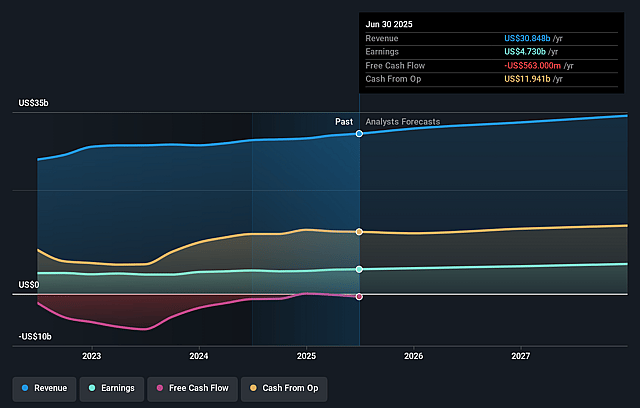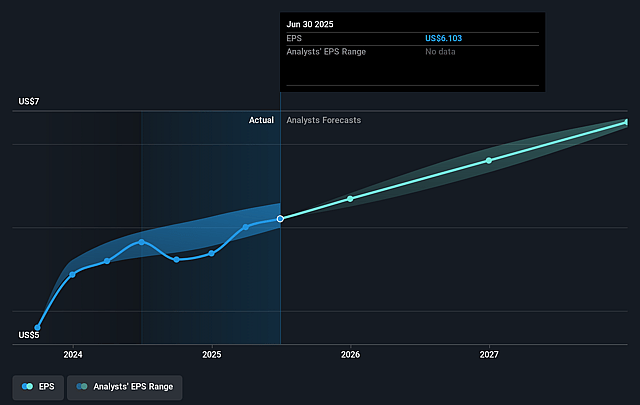Last Update 13 Dec 25
Fair value Decreased 0.94%DUK: Southeast Data Center Demand Will Drive Long Term Earnings Upside
Analysts modestly trimmed their fair value estimate for Duke Energy to approximately $136 per share from about $137, citing slightly lower long term profitability assumptions. At the same time, sector wide enthusiasm around regulated utilities and data center driven load growth supports a higher range of Street price targets clustered around $135 to $143.
Analyst Commentary
Recent Street research reflects a generally constructive view on Duke Energy, with multiple price target increases and fresh initiations underscoring confidence in the company’s growth profile and regulatory positioning. However, not all observers see compelling upside from current levels, with some highlighting valuation and a lack of near term catalysts as constraints.
Bullish Takeaways
- Bullish analysts emphasize that portfolio high grading, balance sheet improvement, and better regulatory structures support a higher fair value range relative to historical levels, reinforcing the case for continued multiple support.
- Data center driven load growth and population expansion in Duke’s Southeast service territories are viewed as structural demand drivers that can support above average rate base expansion and mid to high single digit earnings growth over time.
- High eligibility of planned electric capital expenditures for efficient cost recovery is seen as a factor that may reduce regulatory lag, improve earnings visibility, and support premium valuation relative to many regulated peers.
- Sector specialists highlight what they describe as a rare, long dated investment cycle in U.S. power infrastructure. They argue that integrated utilities with constructive regulation, such as Duke, may be well positioned to add generation assets and translate the cycle into earnings and dividend growth.
Bearish Takeaways
- Bearish analysts note that Duke’s shares already trade at a modest premium to large cap regulated electric peers, and they contend that recent operational and regulatory developments are largely reflected in the stock price.
- Some see limited near term company specific catalysts beyond routine earnings updates, which they believe may limit upside potential even if fundamentals trend favorably.
- Equal weight and sector perform views suggest a balance of risks and rewards at current levels, with valuation leaving less room for missteps in executing the capital plan or delivering on long term earnings guidance.
- There is also caution that, even with sector tailwinds and rising demand expectations, any delays in data center project interconnections or changes in regulatory sentiment could challenge more optimistic growth and valuation assumptions reflected in some Street targets.
What's in the News
- Duke Energy selected three properties in Southwest Ohio and Northern Kentucky for its 2025 Site Readiness Program, targeting high potential business and industrial sites for future economic development investments (Key Developments).
- Through the Site Readiness Program, Duke aims to prepare and market these sites nationwide to companies seeking to start, expand, or relocate operations, reinforcing its role as a regional economic development partner (Key Developments).
- Since 2010, the Site Readiness Program has evaluated 42 sites in Ohio and Kentucky, helping attract over $2 billion in capital investments and 5,400 new jobs from companies such as Coca-Cola, Carvana, Shape Corp., and Niagara Bottling (Key Developments).
Valuation Changes
- Fair value estimate trimmed slightly to approximately $136.18 per share, down from about $137.47, reflecting marginally lower long term profitability assumptions.
- Discount rate effectively unchanged at about 6.96 percent, indicating no material shift in the perceived risk profile or cost of capital.
- Revenue growth increased modestly to roughly 4.97 percent from about 4.90 percent, suggesting a slightly more optimistic outlook for top line expansion.
- Net profit margin edged down marginally to about 16.80 percent from roughly 16.81 percent, implying a very small reduction in expected long term profitability.
- Future P/E decreased slightly to around 21.44 times from about 21.67 times, pointing to a modestly lower valuation multiple applied to forward earnings.
Key Takeaways
- Strong regional economic activity and supportive legislation are expected to drive sustained growth in revenues, earnings stability, and operational efficiency.
- Investment in grid modernization, renewables, and nuclear enhances financial flexibility and positions Duke favorably for the ongoing energy transition.
- Accelerating distributed energy adoption, regulatory risks, capital needs, and fossil fuel reliance threaten Duke Energy's revenue growth, margins, and financial flexibility amid the energy transition.
Catalysts
About Duke Energy- Through its subsidiaries, operates as an energy company in the United States.
- Major economic development wins (e.g., AWS's $10B data center in North Carolina), paired with accelerated migration and manufacturing demand in Duke's service territory, are expected to drive robust, multi-year load and volume growth, supporting higher revenues and long-term EPS growth.
- Supportive state and federal legislation-such as the Power Bill Reduction Act in NC and the Energy Security Act in SC-streamlines cost recovery for new generation and grid investments, reducing regulatory lag and improving cash flow and earnings stability over the next decade.
- Significant infrastructure and grid modernization investment (e.g., over $4 billion incremental CapEx in Florida) is positioned to capitalize on growing needs for digitalization and grid resilience, enabling Duke to enhance operational efficiency and reliability, which benefits both net margins and future rate base growth.
- Proceeds from recent asset sales and the minority stake sale (e.g., Brookfield in Florida) are being used to strengthen the balance sheet and de-risk future equity needs, improving the company's financial flexibility and lowering funding costs, which in turn should protect or expand net margins and earnings.
- Duke's large-scale commitment to nuclear and renewables (operating the nation's largest regulated nuclear fleet, plus long-term renewables investment pipeline) aligns with the ongoing clean energy transition, securing regulatory support and capturing production tax credits-directly boosting earnings and reducing exposure to commodity price volatility.

Duke Energy Future Earnings and Revenue Growth
Assumptions
How have these above catalysts been quantified?- Analysts are assuming Duke Energy's revenue will grow by 4.7% annually over the next 3 years.
- Analysts assume that profit margins will increase from 15.3% today to 17.2% in 3 years time.
- Analysts expect earnings to reach $6.1 billion (and earnings per share of $7.65) by about September 2028, up from $4.7 billion today.
- In order for the above numbers to justify the analysts price target, the company would need to trade at a PE ratio of 21.0x on those 2028 earnings, up from 19.8x today. This future PE is greater than the current PE for the US Electric Utilities industry at 19.9x.
- Analysts expect the number of shares outstanding to grow by 0.67% per year for the next 3 years.
- To value all of this in today's terms, we will use a discount rate of 6.78%, as per the Simply Wall St company report.

Duke Energy Future Earnings Per Share Growth
Risks
What could happen that would invalidate this narrative?- Accelerating distributed energy adoption, such as solar and batteries by customers and businesses, could reduce long-term demand for Duke Energy's centralized grid services and utility-provided electricity, leading to potential stagnation or decline in sales and ultimately pressuring long-term revenue growth.
- Heavy reliance on natural gas and legacy coal infrastructure complicates Duke's transition to renewables, which could result in higher capital expenditures, increased compliance costs, and exposure to stranded asset risk as decarbonization policies accelerate-negatively impacting net margins and future earnings.
- Significant increases in capital needs for grid modernization, generation investments, and new project developments-especially to serve large customers like data centers-raise Duke Energy's dependence on external financing, amplifying vulnerability to persistent inflation and higher interest rates that can compress returns and elevate interest expense, thereby reducing net income.
- While recent legislative and regulatory outcomes have been supportive, any future unfavourable regulatory changes (such as potential shifts to performance-based ratemaking or customer rate resistance) could introduce earnings variability, limit guaranteed returns, or constrain rate base growth, all of which may adversely affect regulated revenue and EPS trajectory.
- Elevated balance sheet leverage and large deferred equity issuance plans heighten refinancing and credit downgrade risks, particularly if capital markets tighten or operational execution falters, which could increase borrowing costs, reduce financial flexibility, and ultimately negatively impact net income and shareholder returns.
Valuation
How have all the factors above been brought together to estimate a fair value?- The analysts have a consensus price target of $132.0 for Duke Energy based on their expectations of its future earnings growth, profit margins and other risk factors.
- In order for you to agree with the analyst's consensus, you'd need to believe that by 2028, revenues will be $35.4 billion, earnings will come to $6.1 billion, and it would be trading on a PE ratio of 21.0x, assuming you use a discount rate of 6.8%.
- Given the current share price of $120.38, the analyst price target of $132.0 is 8.8% higher. The relatively low difference between the current share price and the analyst consensus price target indicates that they believe on average, the company is fairly priced.
- We always encourage you to reach your own conclusions though. So sense check these analyst numbers against your own assumptions and expectations based on your understanding of the business and what you believe is probable.
Have other thoughts on Duke Energy?
Create your own narrative on this stock, and estimate its Fair Value using our Valuator tool.
Create NarrativeHow well do narratives help inform your perspective?
Disclaimer
AnalystConsensusTarget is a tool utilizing a Large Language Model (LLM) that ingests data on consensus price targets, forecasted revenue and earnings figures, as well as the transcripts of earnings calls to produce qualitative analysis. The narratives produced by AnalystConsensusTarget are general in nature and are based solely on analyst data and publicly-available material published by the respective companies. These scenarios are not indicative of the company's future performance and are exploratory in nature. Simply Wall St has no position in the company(s) mentioned. Simply Wall St may provide the securities issuer or related entities with website advertising services for a fee, on an arm's length basis. These relationships have no impact on the way we conduct our business, the content we host, or how our content is served to users. The price targets and estimates used are consensus data, and do not constitute a recommendation to buy or sell any stock, and they do not take account of your objectives, or your financial situation. Note that AnalystConsensusTarget's analysis may not factor in the latest price-sensitive company announcements or qualitative material.




